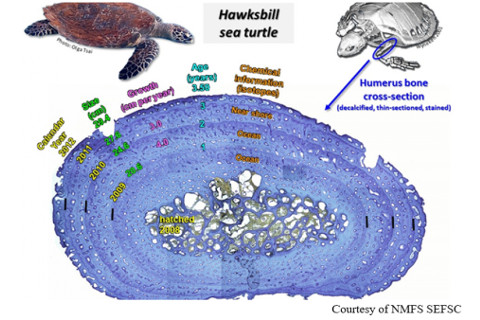Sea turtles are both ecologically vital and complex marine reptiles. Hatchlings start out as eggs laid in nests on beaches all over the world. Once hatched, they float out to sea—otherwise known as the “the lost years” of a turtle’s life. They then move to near-shore feeding grounds, where they potentially stay for decades until reaching sexual maturity. Once fully mature, they migrate, maybe thousands of miles, back to their original nesting beaches for mating. After hatching, it may take 10 to 50 years (depending on the species), to reach sexual maturity. Such complex life cycles and migratory patterns create challenges to study and collect biological and ecological information. This gap in scientific knowledge creates challenges when evaluating management strategies used for populations at risk of extinction.
The threat of extinction has been a consistent danger to Hawksbill Sea turtles. This is particularly due to prolonged harvest in some countries that these turtles frequent. Sea turtles are harvested at all life stages both for their meat and for their “tortoise shell.” Nonetheless, scientists can apply knowledge of species’ size-at-age relationships, growth patterns, and migration movements to better assess human impacts. This allows leaders in the field to deploy increasingly effective management strategies to avoid species extinction.
One way to help current populations is to utilize the trail of clues left over from deceased sea turtles. Using this data, we can recreate an individual’s growth, sexual maturation, and migration patterns. Scientists analyze the bones of sea turtles that wash ashore dead. Those bones are analyzed internally, similar to counting the rings of a tree. In collaboration with the National Sea Turtle Stranding and Salvage Network, we have been able to collect bones from a wide range of areas and time.
The humerus has been found to be the best bone to calculate age from, in most sea turtle species. This is due to the high ratio of compact bone (where the growth-ring is recorded) to spongy bone (eventually erasing initial growth-rings when the animal grows). To be able to count growth-rings like a tree, a sea turtle’s humerus goes through many steps before its clues are revealed. We cut cross-sections just below the neck of the humerus. We then decalcify that section and take even thinner sections to stain. This highlights the growth-rings, making them easier to count and measure.




